Canon XSi: 12.2 Megapixels, Image Stabilized Lens, and Double Live View
by Wesley Fink on May 5, 2008 3:00 AM EST- Posted in
- Digital Camera
XSi Features (cont'd)
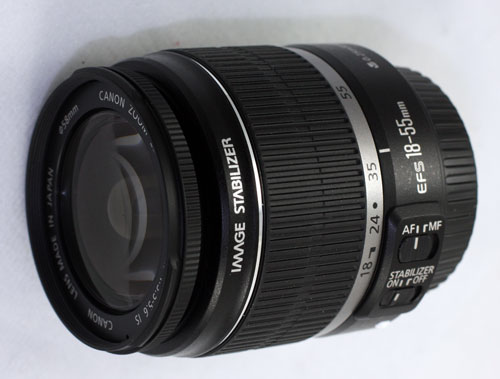
The first Canon 18-55mm lens was introduced with the 6MP Digital Rebel. At the time that lens was heralded as superb quality for a kit lens. The Digital Rebel is now in its fourth generation and resolution is doubled to 12.2MP. What was a great 6MP lens had become a not so wonderful 10MP lens on the XTi and it was time for an update with the move to 12MP.
Canon obliged with several minor changes to the 18-55mm layout and the addition of an aspherical element for one of the lenses. Canon has also developed a new simpler and lower-cost Image Stabilization system that is incorporated in the revised lens. While Optical Image Stabilization is built into lenses and only works with that IS lens it does offer the advantage of showing in the viewfinder, or on the Live View Screen, the true impact of the IS operation.
Mechanical Image Stabilization used by Sony, Pentax, and Olympus works with every lens you mount but you cannot see the effect through the viewfinder. However, recent implementations of Live View by these manufacturers allow the user in some cases to see the true effect of IS on Live View. Those are discussions for another article, but for now Canon, Nikon, and Panasonic have embraced Optical Image Stabilization.
Early testing shows the new 18-55mm IS to be a superb lens with performance comparable to top-line Canon lenses. Including an IS kit lens comes just in time as Sony, Pentax, and Olympus have all adopted mechanical IS built into the body in their entry cameras. Nikon is also offering an optical IS kit lens in their new D60.
Canon claims up to 4 stops of improved hand-holding with the new IS kit lens. We did find we could improve 2 to 3 stops in most situations, but the 4-stop advantage likely requires ideal conditions.
The most remarkable feature of the new IS lens, apart from quality images, is the price. Canon is including the 18-55mm IS for a premium of just $100 over the price of the body. Considering the real advantages of an optical IS lens it is definitely worth choosing the kit with the IS lens as it is $100 that is very well spent for the value received.
PC Remote Control
The prosumer 40D EOS utility software allows the user to remotely control the camera with your computer over a USB connection. This includes the option to record images directly to your hard disk. It was frankly a shock to see this same very Pro-oriented feature available now for the XSi. The utility now works on both the 40D and XSi and allows you to preprogram your PC or Mac for long exposures or for time-lapse photography. You can even focus and preview shots on the monitor in Live View mode.
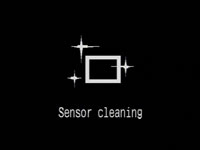
The EOS Integrated Cleaning System, first introduced on the Canon XTi, has been a feature of every Canon camera introduced since then. The system, which vibrates the sensor to shake off dust, is continued unchanged in the XSi.
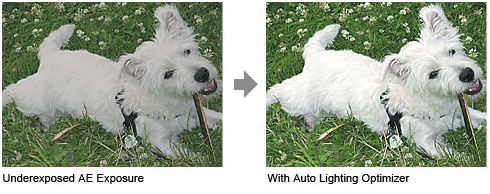
Auto Lighting Optimization is a new option on the XSi. This feature was introduced on the 40D. Canon claims the Auto Lighting Optimizer improves dynamic range and it is on by default. Therefore you can see the impact of ALO in our test images.
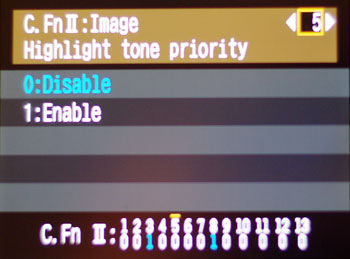
Those who prefer can turn off ALO in Custom Function 6. A related Custom Function 5 allows the user to enable/disable Highlight Tone Priority. This expands dynamic range from 18% grey to bright highlights. The downside is noise may increase in shadow areas. Both these dynamic range expansion features are brought over from the 40D. They work in PASM or A-DEP modes for JPEGs, but have no effect on images captured in RAW format.
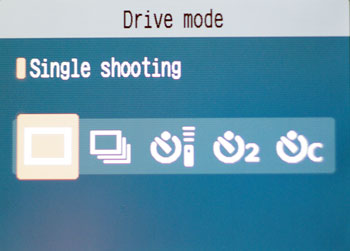
Continuous shooting is up to 3.5FPS, a slight increase from the 3FPS of the XTi despite the 20% increase in sensor resolution and image size. This makes the XSi one of the fastest entry DSLRs available in continuous mode. From the 40D the XSi also adds a 2 second timer mode (with optional mirror lockup) which is convenient for tripod shooting. The self-timer C option in the LCD screen shot above counts down from 10 seconds, but then takes a user selectable one to ten shots in succession to keep you from having to go back to the camera for second or third attempts.

The Rebel XSi is packaged in a big red splashy box for the US market. In Europe, where it is called the 450D, the packaging is a much more subtle Canon grey and black.
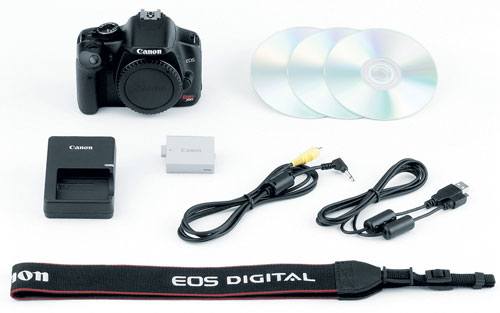
In the box you will find the rechargeable battery, charger, USB cable, video cable, Canon neck strap, software CDs, manuals, and warranty card(s). The most common kit with a lens includes the new 18-55mm f/3.5-5.6 IS (optical Image Stabilized) lens.










56 Comments
View All Comments
pinto4402 - Monday, May 5, 2008 - link
Your observation about Canon's overly warm/red WB in tungsten lighting is shared by many camera reviewers/users. It's a "problem" that has been noted for a long time. Some people actually prefer the overly warm colors, though. I'm sure this is the reason why Canon has never fixed their WB.Deadtrees - Monday, May 5, 2008 - link
"Working range AF specifications are the same EV range of -0.5EV to 18EV. However, the 40D adds an additional diagonal cross-type sensor with greater precision for f2.8 lenses, providing better support for fast Canon L lenses."- Not trying to be picky or anything but that is somewhat misleading as not all L lenses have aperture values faster than f/2.8.
-------------------------------------------------------------------
"Overall, the Sony A350 actually does better against the Canon XSi than we really expected and acquits itself quite well for a higher resolution sensor that should be showing greater noise than the Canon XSi. Resolution and noise control to ISO 1600 on the Sony holds its own against a sensor maker than has been the low-noise standard since DSLRs began."
- Keep in mind that A350 utilizes quite agressive noise deduction algorithms resulting smudged water color like images. If you think less noise is good no matter what, I guess it's not so bad. But, what about details that are lost? Do you really want over 10mp dslr images to show details as cell phone cameras? Hell, in that case, even point-and-shoot panasonic cameras that are known for crazy noise reduction algorithm can compete head to head with Nikon D3.
---------------------------------------------------------------------
BTW, I really suggest you to change the test subject. It's glossy coated hardboard papers which makes it virtually impossible to see the loss of details caused by insance noise reduction algorithms.
Lord 666 - Monday, May 5, 2008 - link
Wes,If you are comparing the XTi vs. XSi vs. 40D, why not include the D300 as well to compare against?
Wesley Fink - Monday, May 5, 2008 - link
We will include the D300 results in Part 2 of our Digital Sensor article. We will be comparing resolution and noise in different sensor categories, such as 14 megapixel, 12 megapixel, and 10 megapixel.I did toy with the idea of including the D300 in comparisons in this review, but I figured Canon to past Canon XTi to top Canon prosumer 40D was a bit more logical than a $800 body to a $1800 body. I'll leave that comparison for the digital sensor article.
complectus - Monday, May 5, 2008 - link
Is that a Frank Lloyd Wright house in 2 of the Sample Images?Wesley Fink - Monday, May 5, 2008 - link
Yes it is Frank Lloyd Wright. I am fortunate that a real Wright house is in my neighborhood. The furniture was also custom built for the rooms in th eWright house, as was typical of many of his home designs.It was built in the early 1900's and is contemporary to the other homes in the photographs. I figured someone would catch it.
pinto4402 - Monday, May 5, 2008 - link
For about five minutes, I was interested in the Xsi as a lightweight backup camera body for event photography. However, the lack of a CF card slot completely nixes this idea. It doesn't make any sense for Canon to switch from CF to SD, other than to attract P&S owners who want to migrate to a DSLR. By doing so, however, Canon effectively excluded us existing DSLR owners who already have many of their lenses and who would be more likely to purchase. I can tolerate the Xsi's plastic body, but I'm not going to invest in new storage media just to use this camera.Wesley Fink - Monday, May 5, 2008 - link
You can buy a 16GB class 6 hi-speed SD card for $55, a 4GB Class 6 for about $20, or an 8GB for around $30. I can't believe that small expense would keep you from buying and using the XSi if you really wanted to.Nikon uses SD on the D80 and D60, Pentax uses it on the K20D and K200D. Sony still uses CF, but new Sony lenses cost a lot more than today's cheap SD and CF memory.
RDaneel - Monday, May 5, 2008 - link
I have no problem with AT doing camera reviews, I think it's a valuable perspective for hobbyists and prosumers. Obviously AT isn't going to review $1500 lenses...That being said, this review reads more like Canon ad copy than a real comparative review. There isn't any serious examination of the image quality, and it feels like more effort is spent in comparing the number of AF points and megapixels than really looking at the camera as a DSLR system or really talking about IQ. Just kind of a disappointment, normally the objectivity on AT is a bit better. Did the author get to keep the free press sample? ;)
Wesley Fink - Monday, May 5, 2008 - link
There was no Press sample - not even a loaner. We had to buy the XSi that was reviewed. The same goes for the Nikon D60 and Sony A350 that were compared to the XSi. Since we bought them all we owe nothing to any manufacturer.The XSi won't replace my D300 or my Pentax K20D, but it is a really superb entry camera.